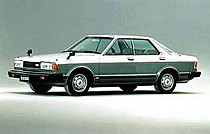
Nissan began realigning its export names with its home market names with the 910 series in November 1979. The ‘B’ tags were dropped in favour of ‘Bluebird’, though the models were marketed as ‘Datsun Bluebird’ initially. The Bluebird 910, which was the last rear-wheel drive Bluebird, featured simple clean-cut squared-off lines, unlike the “Coke Bottle” styling of its predecessor. It did however retain the same engine range, the same MacPherson strut suspension and the same wheelbase as the 810.
It went on sale in Europe over the summer of 1980, where its main competitors were traditional rear-wheel drive saloons including the Ford Taunus/Cortina and Opel Ascona/Vauxhall Cavalier. It also had a number of front-wheel drive rivals, including the Peugeot 305 and Renault 18. Nissan had enjoyed significant sales success in Britain since the early 1970s and the Bluebird sold reasonably well there, although it was not as popular as the smaller Cherry and Sunny.
For the export models, a ‘Nissan’ badge began appearing in 1981. However, in Australia, where 130,000 910s were built between 1981 and 1986, the name change from Datsun Bluebird to Nissan Bluebird did not occur until 1983.
After eight years the Bluebird returned to the Taiwanese market. Yulon had replaced the Bluebird with the Nissan Violet in 1971. The new model was considered to be in a new class and was now known as the Yue Loong Bluebird 911. Until then, Yue Loong had reserved the 900-series for the larger Laurels. After a facelift, the car became the 912.
Nissan New Zealand assembled several versions of the Bluebird 910. These were shipped in CKD from Japan, including a top ZX model that was the first, and only, car to be assembled in the country with electrically adjustable Japanese domestic style ‘hockey stick’ rear view mirrors on the front guards (which had to be sent out after kit unpacking for a local specialist to stamp the mounting holes). NZ cars initially had the two-tone brown interior; this was switched to grey at the mid-life facelift when the top model’s power exterior mirrors were relocated to the door mounting now universal today. Japan itself eventually phased out the mandatory wing-mount mirrors that also distinguished thousands of used cars imported from Japan into NZ in the late 1980s and early 90s.
In Japan, the six-cylinder Bluebird of the 610 and 810 series was replaced by the Skyline based Nissan Leopard with the Bluebird returning to four-cylinder powered vehicles. The Leopard joined the Bluebird at Nissan Bluebird Store Japanese dealerships.
The Bluebird was also made in South Africa (Pretoria) 1978 to 1980 as well and was called the Datsun 1600J Deluxe, 1800j deluxe or 1800J SSS Sedan which had the twin carb set up and a five speed gearbox. A station wagon version with a 1600 cc engine was also made. The cars had the L16 or L18 engines. After a while the cars model name changed to the Datsun Stanza. The cars were all rear wheel drives with solid axle and coil springs. These cars were the last models to have the name Datsun as the later models all had the name Nissan due to the global name change. This car was very popular as it reminded people of the Datsun P510 models made in 1969 to 1973 in South Africa.
The Maxima name first appeared in this generation. In the United States, these models were sold as the 810 Deluxe or Maxima. The Maxima name was solely used from 1982. The 910 name was never used in Australia.
This is the generation that spawned the S130 Fairlady Z, and in turn, the Z31 and Z32 Fairlady Z’s using updated versions of the platform of this generation.
A one-off convertible was built by Nissan for use as a bullpen car by the Yokohama BayStars (now the Yokohama DeNA BayStars). It was the first of such bullpen cars that Nissan would provide for their hometown team.
Australian production
Australia had the 910 from 1981 to 1984 with the L20B engine, and from 1985 to 1986 with the CA20S engine. In the United States, the 910 was offered as the Datsun 810/Maxima with either the 2.4-liter L24E inline-six or the 2.8-liter LD28 diesel inline-six. The Australian model was a downgraded, locally produced version of the Japanese model with no independent rear suspension, electronic fuel injection, or turbo versions. However, the cars were offered in a sporty version, known as the TR-X. The main difference between these Bluebirds and the base models are a sporty trim, including an optional front air dam, centre mount aerial, 15-inch alloy wheels, a small rear spoiler, map lights, seats with better bolstering and so forth. Mechanically, the cars were not much different, the only main differences to be found are rear disc brakes which were shared with the LX and a 3.9:1 diff ratio compared to the standard 3.7:1.
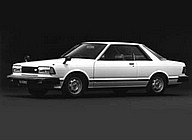
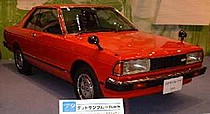

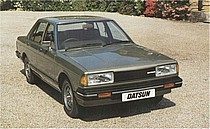
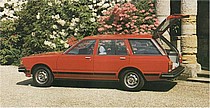
Also called Nissan Bluebird 910 , Yue Loong Bluebird 911/912 (Taiwan), Datsun 180B (GCC)
Chassic codes: 910, KM910, M910, ML910, WM90, WML910
Assembly Japan, Miaoli, Taiwan, Clayton, Victoria, Australia
Designer Isao Sono (1976)
Body style 4-door sedan, 4-door hardtop, 2-door hardtop coupé, 5-door station wagon
Layout FR layout
Engine
1595 cc L16 I4
1595 cc Z16 I4
1770 cc L18/L18E I4
1770 cc Z18/Z18E I4
1952 cc L20B I4
1972 cc CA20S I4
1952 cc LD20 diesel I4
Transmission 4/5-speed manual, 3-speed automatic
Dimensions
Wheelbase 2,525 mm (99.4 in)
Length Saloon: 4,350 mm (171.3 in) Estate and Coupe: 4,400 mm (173.2 in)
Width 1,650 mm (65.0 in)
Height Saloon and Estate: 1,400 mm (55.1 in) Coupe: 1,380 mm (54.3 in)
Curb weight Saloon and Coupe: 1,135 kg (2,502 lb) Estate: 1,130 kg (2,491 lb)
![]()
Hi
I had a 1981 leopard
And I have loads of brand new parts
It’s a long story but basically I was having it restored and the company went bankrupt and I lost the car as the torched the building
If your interested I can’t send you details of the parts
Mainly door rubbers door seals for the windows
Lights
Mouldings and few other parts
Thank you
Hi Shaun,
Sadly the leopard was never sold in the UK. There has been a few imports. Probably worth selling on places like Ebay.